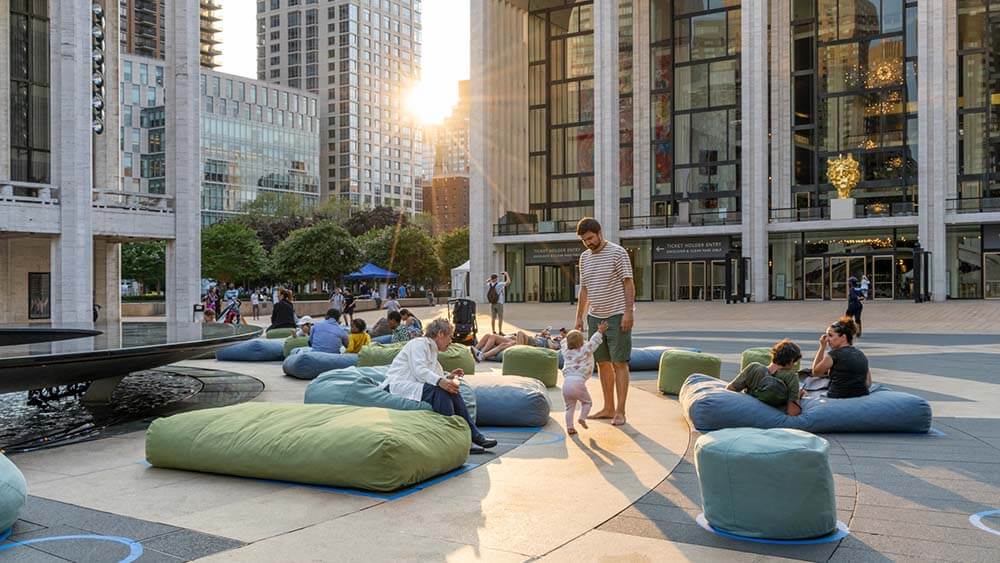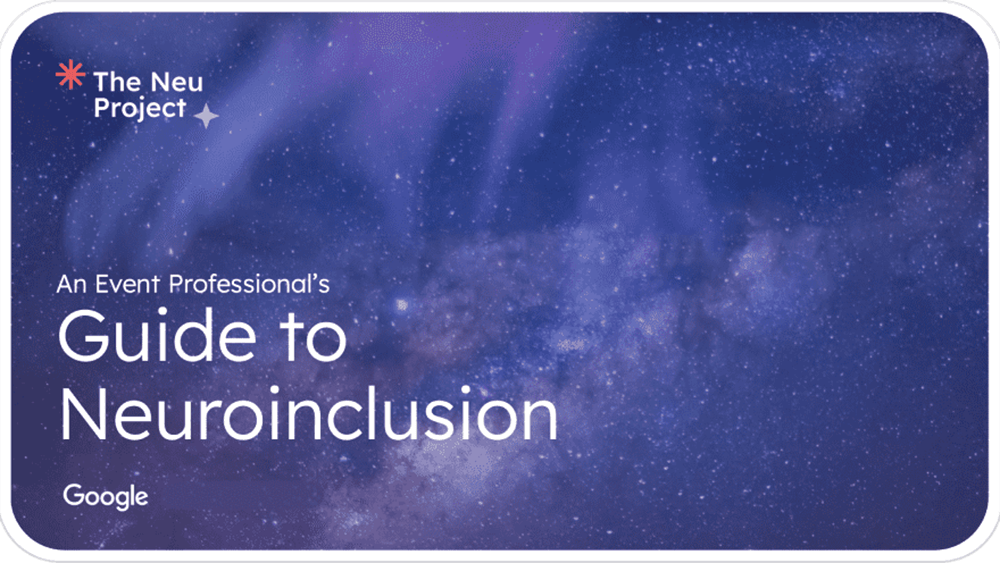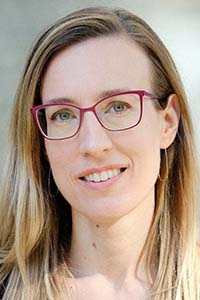
‘Softy’ was an installation at the neuroinclusive Big Umbrella Festival at Lincoln Center in New YorkCity. Keep scrolling to learn more about ‘Softy’ and the festival. (Courtesy Bryony Roberts Studio/Michael Vahrenwald)
It may seem like Google, the world’s largest internet search engine company, always has the answers. But in terms of understanding how events fit into a business strategy for both external and internal audiences, in mid-2021, even Google “had a lot of big questions that we didn’t have any good answers to,” Megan Henshall, CMP, DES, the company’s strategic solutions lead for event solutions, told Convene.
“And so we thought, well heck, let’s bring smart people together,” Henshall said. “Let’s get out of our Google bubble and try to build a community around some of this uncertainty so that we can expedite everyone’s journey.”
The coalition that emerged, which came to be called Google Xi (short for Experience Institute), gathered people from both inside and outside the industry, individuals that Henshall described as “event leaders, disruptors — people who were just doing cool, novel, refreshing things in the experience space together.”
That was in August 2021. A couple of months into their discussions, the group started to notice “some really interesting data and emerging cultural and behavioral trends, signaling that the two years of work from home and social isolation had given people a lot more clarity on their boundaries, their limitations, and their needs,” Henshall said. During the pandemic, it seems, “we all got a little more clear on what it is we need, what it is we’ll accept or tolerate.
“We started to realize that social norms have actually evolved as a result of these last two years,” she said. Audiences were saying that things like longer breaks, not being overscheduled, and having time built into agendas for resilience and recovery would be useful to them, she said. “We started to translate these broader cultural and behavioral insights into ways that could reshape or reimagine how we design events and experiences.”

Megan Henshall
A Personal Journey
At the same time, Henshall’s son Otis, then four-and-a-half, was diagnosed with autism. Otis “is brilliant and perfect in every possible way,” Henshall said, “but his journey is going be different from a neurotypical child. And I want to understand how to be the best resource, ally, and advocate that I can for him.” As Henshall set out on her own journey of discovering how to be the best possible mom she could be for him, it occurred to her that she should be talking to autistic adults about what worked for them as children — what their parents had done for them that felt supportive and right, she said.
As she was thinking that through, a lightbulb went on. “All of these dots were connecting,” she said. She realized “that if I want to learn, I need to go to the source,” she said. And that went for events as well. In order to include neurodiverse people in events, “we need to be talking to as many neurodivergent people as possible to get a really good sample size of what it is like for them to go to an event.”
The Experience Institute’s focus on the topic of neurodiversity led to The Neu Project, a community which has collaboratively created resources to organize events that embrace all neurotypes. In October, the project launched a website where users can download “An Event Professional’s Guide to Neuroinclusion,” with modules covering information about language and identity, neurodivergent brain types, tips on creating neuroinclusive spaces and policies, a glossary, and more. (See “Sensory Sensitivity” below.)
Henshall, who has spoken at a series of in-person, digital, and hybrid events about the initiative and has been leading the project, said her voice “is not the important one. We have this whole amazing community of neurodivergent people — speakers, educators, and influencers — who are available to the events community as resources. That’s what it’s all about, listening to them and learning from there and then figuring out how to implement, based on what we’ve heard.”
Here’s more of what Henshall had to say about the project:
On how the Experience Institute built a network of neurodiverse experts:
“We got curious and we started to do an audit of who is doing neuroinclusive events. What resources exist? How are people thinking about different brains and holding space for them in events? We couldn’t find anything, and we were bummed. And so we decided to build it.
“One of the most interesting — but also maybe one of the most tragic — things we saw when we first started to look for existing resources is that so much of what does exist is through the lens of academics or ‘experts’ on neurodiversity. I’m not detracting from people who have studied this or people who have gone to school to support neurodivergent people. But they themselves do not have the lived experience.
“We did an open call on LinkedIn. We met a couple of people and they introduced us to friends. It all happened organically. We found brilliant people who were unmasking in their own
ways and telling their own stories and decided to amplify them. I am so proud of the community that we’ve built around this project. They are incredibly accomplished, kind, big-hearted people, and we’ve learned so much from them.”
On how the impacts of designing neuroinclusive events can benefit everyone:
“The potential effects for the broader population with neuroinclusion are limitless. Limitless. Based on what we’re seeing around emerging behav- ioral trends, prioritizing neuroinclusive [design] benefits every single person that walks through the door of your event.
“And this sort of work — better understanding the variety of brains and people and needs and appetites that are showing up to our events — has led us down the path to experiment with a whole laundry list of what we’re calling the multimodal language. Color, light, scent, biophilia — how we tactically engage in play and moments of joy.
“We are prototyping and piloting and playing around with what could be really low-tech ways of connecting audiences with stories, messages, content, but also with one another. There have been so many interesting things that we have learned and will continue to explore due to the new projects and what we’ve heard.”
On where to start:
“I think this type of work is scary for people. Quite frankly, it scares me. I was scared to launch it. For those of us who are neurotypical and trying to be good allies and advocates and designers for neurodivergent people, we’re terrified that we’re going to get it wrong, or use the wrong word or not understand something around cultural sensitivity. That we’re going to mess up — and you will. But it’s okay. As long as you’re coming from an earnest, authentic, vulnerable place in this sort of work, you’re not going to get it wrong.
“More than 20 percent of the global population is neurodivergent in some way — that’s 1.5 billion people on Earth. That translated to one in five people on our teams, at our events, in our families, in our communities. And if that is not your lived experience as a neurotypical person, that means there are probably people around you who are masking or hiding their authentic selves, because they don’t feel safe to share that. So, I think the best place to start is to open up the conversation and make it safe to talk about it.”

Sensory Sensitivity
Neurodivergent reactions to external stimuli — sights, smells, lights, colors, sounds — as well as differences in processing social interactions can hamper attendee experience at events. The Neu Project’s guide to neuroinclusive events includes tips for designing events and event spaces that support the needs of neurodivergent attendees. They include:
- Use non-stimulating colors when designing neuroinclusive spaces, such as blues, greens, pinks, and browns, with yellows and oranges used minimally for event areas requiring energy bursts. Minimize or avoid red as much as possible — studies show this high-intensity hue may trigger sensory overwhelm. Stark white, bare walls may increase anxiety, because of their cold appearance.
- Avoid prolonged exposure to harsh lighting and strong smells and warn attendees in advance about sound or light activations.
- Create sensory recovery spaces — like quiet rooms, prayer rooms, and lounges. Offer sensory aids like sunglasses, fidgets, and sound filtering headphones to make spaces more comfortable.
- Social functions can be particularly “energy expensive” and overwhelming for neurodivergent attendees. Offer quieter, more intimate areas for conversation during social functions.
From “The A-Z of Neuroinclusive Events,” in “An Event Professional’s Guide to Neuroinclusion”
‘What It Takes to Make Us Feel at Ease’
The Big Umbrella Festival got its start when Lincoln Center in New York City commissioned a local theater company to design a show for young people on the autism spectrum. From that performance, the event has grown to a three-day-long festival of installations, workshops, and online content designed with and for neurodiverse audiences, the first of its kind.

Bryony Roberts
This year, the festival included the installation “Softy,” a collection of puffy, oversized cushions placed around a fountain at Lincoln Center. The cushions could be moved to create areas for play and socializing and to create private spaces around the edges, where participants could find a quiet spot away from crowds.
The installation was the work of designer Bryony Roberts, who is one of a growing number of architects and designers who create inclusive public spaces meant to offer a range of sensory experiences. In a video lecture presented by the Southern California Institute of Architecture, Roberts defined neurodiversity as “the infinite varieties of human brains and the range of sensory processing.” It often describes autism but also can describe anxiety and PTSD — “all of these things,” Roberts said, “affect our sensitivity to light and sound and social interaction — what it takes to make us feel at ease.
“In the wake of the pandemic, it’s been particularly important to think about the sensory dimension of public space,” she said, “as so much trauma and loss have been experienced by so many people. It’s an important moment to bring in this layer as we think about creating truly inclusive public spaces.”
Barbara Palmer is deputy editor of Convene.
